Introduction
Excessive alcohol (ethanol) intake or alcohol abuse can lead to many health problems and is implicated as a cause or an aggravating factor for various skin conditions.
What is alcohol abuse?
Alcohol abuse has been defined as recurrent Drinking alcohol where it impacts work, school, or home, or to the point of being physically dangerous, gets you in trouble with the law, or continues despite the problems it has created.
Health problems due to alcohol.
Alcohol intoxication
The effects of alcohol intoxication include:
- Heart: slow heart rate or irregular rhythm, low blood pressure
- CNS: headache, confusion, memory loss, disorientation, lack of coordination, emotional lability
- Gastrointestinal: nausea and vomiting.
- Respiratory: asthma, slow or heavy breathing.
Chronic Alcohol abuse
The effects of chronic alcohol abuse include:
- Heart: high blood pressure, heart failure, irregular heartbeat
- Haemostasis: coagulation is impaired with reduced survival and aggregation of platelets and reduced thromboplastin
- Endocrine: low testosterone levels with loss of libido, testicular atrophy, impaired fertility and facial reduction hair, high estrogen levels with gynecomastia, fat change distribution and loss of body hair
- Esophagus: ulcervaricose veins Cancer
- Liver: hepatitis, cirrhosis, gallstones
- CNS: dementia, poor coordination, Wernicke Korsakoff syndrome (Vitamin B1 deficiency) associated with psychiatric and visual disturbances
- Immune system: direct toxic effect on bone marrow, reduced number and function of T cells, reduced survival of immunoglobulins.
The infographic below shows the effects of alcohol on the body (provided by Healthline).

Vascular effects of alcohol
Facial flushing
One of the first signs of alcohol abuse is a persistent red face due to enlargement blood vessels (telangiectasia) This appears because the regulation of vascularization control in the brain it fails with sustained alcohol intake.
Redness
Transient flushing is also a common side effect of alcohol, particularly in heavy drinkers. It is due to acetaldehyde, the main breakdown product of alcohol. Acetaldehyde is believed to cause redness by stimulating the release of histamine.
Up to 40% of Northeast Asians experience flushing and an elevated heart rate after drinking even minute amounts of alcohol, due to accumulation of acetaldehyde. This is due to a mutation in acetaldehyde dehydrogenase (ALDH2), the enzyme which converts acetaldehyde to acetate.
Vascular effects of alcohol.
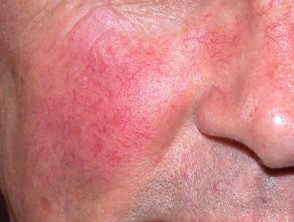
Facial flushing
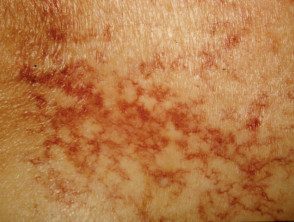
Telangiectasia
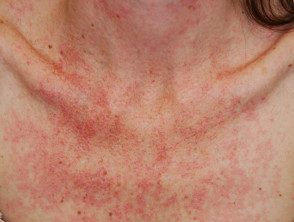
Redness
Skin changes due to liver disease.
Spider telangiectasia
Spider telangiectasia gets its name because of its appearance. Blood vessels (spider legs) radiate in all directions from one center blood vessel (your body) Like other blood vessels, the spider angiomas whiten when pressure is applied. They can press. They are most often found on the face, neck, chest, arms, hands, and abdomen.
Large number of spiders telangiectasias are associated with liver cirrhosis (scarring of the liver) due to elevated estrogen levels. A study of 82 patients with liver cirrhosis showed a significantly higher number of spider webs in alcoholic cirrhotic patients than non-alcoholic cirrhotic patients, indicating that there may be an additional effect as vasodilation to account for this difference.
Small amounts of spider telangiectasias are seen in healthy children and adults. They are more common in women, especially during pregnancy, as they are influenced by the female hormone, estrogen.
Palm erythema
Chronic alcoholic liver disease can lead to redness of the palmar skin. This is also believed to be due to estrogen, as is sometimes seen during normal pregnancy.
Caput medusa
High pressure inside venous system in the liver leads to high pressure in the venous system in other parts of the body, including the veins around the belly button (belly button). When these veins are dilated, the appearance resembles "caput medusa" (Medusa's head), referring to Greek mythology where a beautiful woman was once cursed and her hair turned into snakes.
Jaundice
Skin and sclerotic of the eyes often turn yellow in patients with alcoholic liver disease. The color, known as jaundice, is due to bilirubin, a broken down product of heme derived from red blood cells. the metabolism of bilirubin deteriorates in acute and chronic liver disease. Jaundice decreases as liver function improves.
Skin changes due to liver disease.

Naevi spider

Palmar erythema
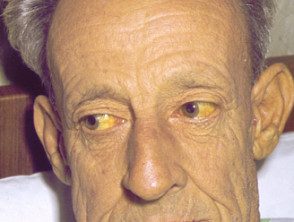
Jaundice
Hyperpigmentation
Darkening of the skin (hyperpigmentation) around the eyes, mouth, and legs may be associated with chronic liver disease. The reason why this occurs is unclear.
Generalized pruritus
Generalized itching of the skin (pruritus) can occur due to the accumulation of poorly metabolized substances that stimulate the nerve endings in the skin. These substances can include bile salts, histamine, corticosteroids, and opioids.
Nail changes
Nail changes associated but not specific to alcohol-related liver disease include:
-
Clubbing: The nail sticks out rather than dipping a bit before meeting the skin at the root of the nail, resembling a stick. The angle between the nail plate and proximal The crease of the nail is called the Lovibond angle and is typically less than 180 ° (indicating a dip and rise where the nail and skin meet).
- Coilonychia: the opposite of nailed nails. Instead of bulging, the nail plate is flat or sunken (concave or spoon-shaped). This finding is often related to iron deficiency.
- Terry nail: two thirds of the nail are white and the last 2 mm are pink. This may be due to a reduction capillary blood flow in the nail bed.
- Muehrcke's nails: white bands running parallel to the lunula (nail moon) with normal pink nail between the bands. This sign it may be due to a low level of protein in the blood (hypoalbuminaemia).
- Red lunula: change in the color of the nail moon to red, possibly due to increased blood flow and vasodilation
Nail changes sometimes associated with liver disease

Clubbing

Coilonychia

Muehrcke Nails
Cutaneous porphyria delays
Porphyria cutaneous late (PCT) causes photosensitivityskin fragilityblisters erosionsscabs milia, scleroderma and increased hair growth (hypertrichosis) in places exposed to the sun such as the face and hands.
Alcohol is the most common cause of acquired or type 1 PCT in susceptible individuals and is associated with chronic liver disease. Porphyrins accumulate due to deficiency of uroporphyrinogen decarboxylase (UROD), an enzyme important in the synthesis of the blood protein heme.
Other factors that can trigger type 1 PCT include estrogen, iron, and viral infections (especially hepatitis C). Family or PCT type 2 is due to genetic UROD deficiency.
Cutaneous porphyria delays
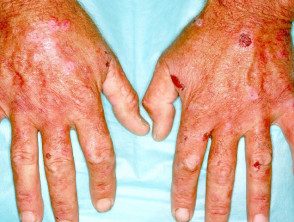
Cutaneous porphyria delays
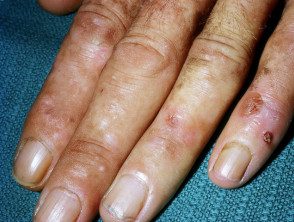
Cutaneous porphyria delays

Cutaneous porphyria delays
Skin cancer
In addition to increasing the risk of liver, pancreatic and breast cancer, alcohol increases the risk of skin cancer, including scaly cell carcinoma, basal cell carcinoma and melanoma. Alcohol is also associated with an increased risk of oral cancer.
Reasons that heavy alcohol use can cause cancer include:
- Alcohol suppresses the immune system and impairs proper nutrition, reducing the body's natural defense against skin cancer.
- His main metabolite, acetaldehyde, is a carcinogen (chemical that causes cancer). Acetaldehyde produces reagent free radicals and damage DNA.
- The effects of Ultraviolet radiation it can be enhanced with photosensitizing by-products of alcohol.
- Alcohol abuse is associated in many people with tobacco use.
Skin cancers

Squamous cell carcinoma
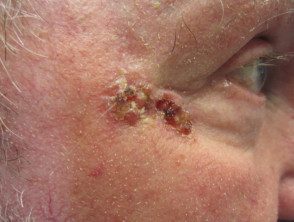
Basal cell carcinoma
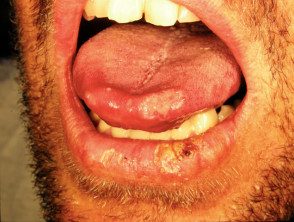
Oral squamous cell carcinoma
Nutritional deficiency
Nutritional deficiency can develop when alcohol replaces normal foods in the diet and the digestive tract and liver do not digest and process food in the way it should cause malabsorption. With little calorie or protein intake, the skin dries out and loses elasticity.
Vitamins are essential to maintain healthy skin:
-
Vitamin A deficiency produces xerosis (dry skin) and follicular hyperkeratosis (rough follicles)
- Vitamin B1 (thiamine) deficiency produces waxy skin and a red thickened tongue.
- Vitamin B2 (riboflavin) deficiency occurs with angular cheilitis (cracked corners of the mouth), atrophic glossitis (swollen tongue) and a eruption in the face that looks like seborrheic dermatitis.
-
The pellagra it is a deficiency of niacin (vitamin B3) and presents with the three “ds”: diarrhea; dementia and dermatitis in areas exposed to the sun. Cheilitis and glossitis are also a feature.
- Vitamin C deficiency (scurvy) causes inflamed gums, follicular hyperkeratosis, and corkscrew hairs.
- Zinc deficiency causes a condition known as acquired acrodermatitis enteropathica with dermatitis around the mouth, hands, feet, and anus.
Signs of vitamin deficiency.
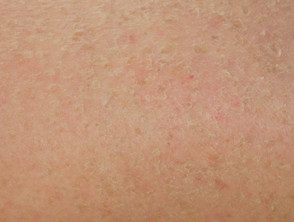
Dry Skin

Follicular keratosis
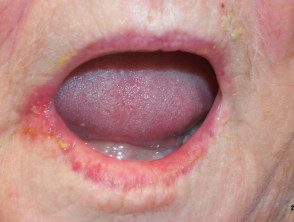
Angular cheilitis
Oral changes due to chronic alcohol consumption.
Changes found in the mouth are often related to nutritional deficiency or poor oral hygiene. These include:
- Dry lips (cheilitis)
- Inflammation of swollen gums / gums (gingivitis)
- Caries (cavities)
- Red, smooth tongue with meat associated with vitamin B deficiency
-
Hairy tongue associated with overgrowth of bacteria
Also, swelling of the parotid gland it can be the result of chronic alcohol use.
Oral changes associated with chronic alcohol use.
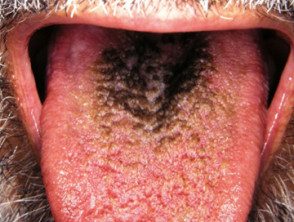
Black hairy tongue
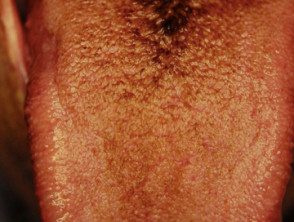
Black hairy tongue
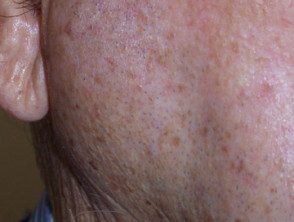
Parotid swelling
Skin conditions affected or caused by alcohol.
All of these skin conditions can occur without a history of alcohol abuse.
Rosacea
Alcohol induces vasodilation and facial redness in people with rosacea. However, alcohol is not the cause of skin disease in most people.
Although the classic "drinker's nose" (rhinophyma) was thought to be related to excessive alcohol consumption, it has never been proven. In a case-control study of 175 people with rosacea and 145 people with normal skin, there were no significant differences in alcohol consumption between the two groups.
Rosacea
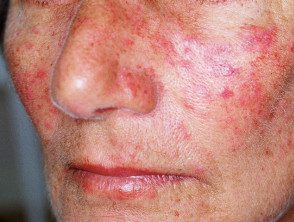
Telangiectatic rosacea
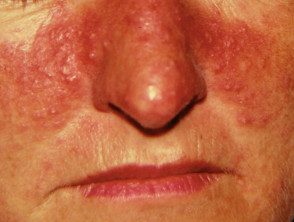
Papulopustular rosacea
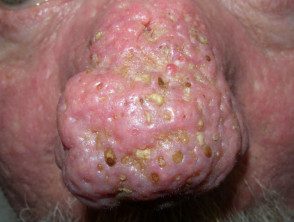
Rhinophyma
Psoriasis
High alcohol intake is a risk factor for a new onset of psoriasis. The distribution of psoriasis has been observed to be particularly prominent on the fingers and hands of heavy drinkers. People who have psoriasis and drink more than 80g of alcohol per week have been found to have more severe, refractory psoriasis, including erythrodermic psoriasis. The reasons for the association may be relative. immunosuppression alcohol-induced and / or inducing proinflammatory cytokines.
Heavy drinking reduces your options for psoriasis treatment, as some medications are contraindicated If alcohol consumption has caused liver disease (methotrexate) or high levels of triglycerides (acitretin) Patients with psoriasis and heavy alcohol consumption are also more likely to suffer from depression.
Psoriasis

Psoriasis of the scalp
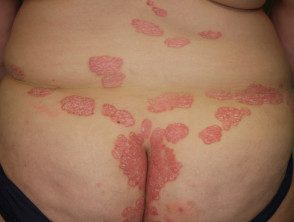
Chronic plaque psoriasis
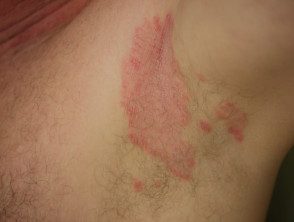
Flexural psoriasis
Seborrheic dermatitis
Seborrheic dermatitis has been found to be more common in heavy drinkers.
Seborrheic dermatitis
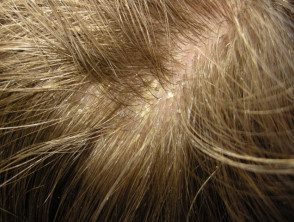
Seborrheic dermatitis
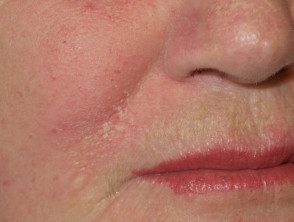
Rosacea

s
Nummular dermatitis
Nummular or discoid Dermatitis occurs most often in people who abuse alcohol, particularly those with abnormal liver function tests.
Nummular dermatitis

Nummular dermatitis
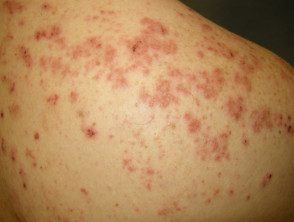
Nummular dermatitis
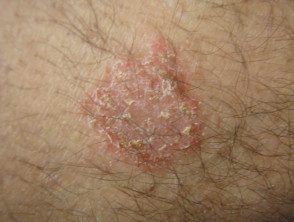
Nummular dermatitis
Skin infections
Skin infections occur more frequently in patients who drink alcohol excessively due to impaired immune system, nutritional deficiency, and increased trauma. These include:
Bacterial skin infections that can lead to septicemia (spread to the blood):
- Group A and G streptococci
- Staphylococcus aureus
- Corinebacteria that produce erythrasma and boneless keratolysis
Fungal skin infections are common but rarely cause septicemia. They include:
- tub infection
- onychomycosis
- pityriasis versicolor
Tuberculosis is also seen more frequently in alcoholics. The skin involvement is called cutaneous tuberculosis.
Skin infections sometimes associated with excessive alcohol consumption.

Wound infection

Cellulitis
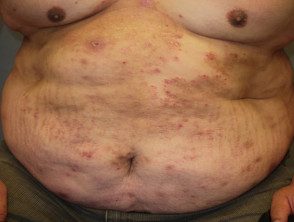
Ringworm of the body spread
Urticaria
Hives (urticaria) can occur within minutes to hours after drinking alcohol and is sometimes due to allergic reaction. Flushing and overheating after drinking alcohol can also indicate cholinergic urticaria. This is a physical type of hives that causes me heat, exercise or stress.
Urticaria

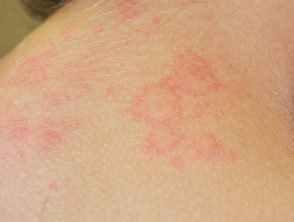
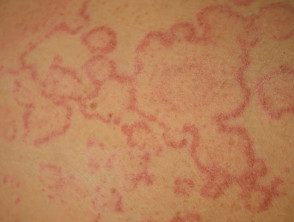
Objective lesion in urticaria.
Sensitivity to alcohol
Alcohol can lead to allergies or allergy-as symptoms. Along with hives (see above), patients can develop low blood pressure, diarrhea, shortness of breath, and low heart rate (anaphylaxis) Even small amounts of alcohol can induce hives in people who have had a severe reaction before, although allergy tests are often negative.
Some apparent allergic reactions alcohol are due to inherited defects in alcohol metabolism enzymes or allergy to other contents of the drink, such as coloring agents, preservatives or flavorings.
Interactions of alcohol with dermatological medications.
Some medications used to treat dermatological disorders should not be taken with alcohol. Examples include:
-
Metronidazole - causes unpleasant symptoms including flushing, palpitations, sweating, dizziness, headache, nausea, and vomiting.
- Antihistamine sedatives: increased drowsiness and dizziness, driving problems
-
Tricyclic antidepressants: increased drowsiness and dizziness, driving problems.

